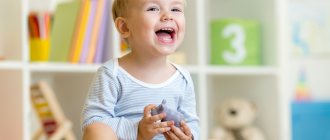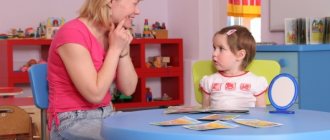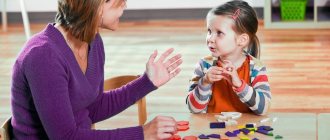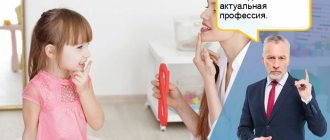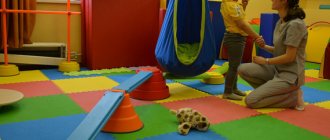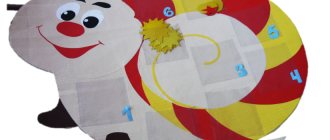Books that systematically present the basics of knowledge in the field of correction of speech disorders at the current level of scientific achievements are textbooks on speech therapy. Books on speech therapy for students are the main and leading type of educational and methodological literature. The tutorials are presented in order of importance. This page can be supplemented and corrected. The Jobs page describes ways to collaborate with the site in this area.
Methodological literature for speech therapist teachers
Diagnostic material
Inshakova O.B. Album for a speech therapist. — M.: Humanite. ed. VLADOS center, 1998.
The album provides illustrated material for examining the oral speech of children of senior preschool and primary school age, which allows us to identify violations: sound pronunciation, syllabic structure of words, phonemic analysis and synthesis, vocabulary and grammatical structure of speech.
Visual material for examining children. Appendix to the methodological manual “Psychological and pedagogical diagnostics of the development of children of early and preschool age” / ed. E.A. Strebeleva - Moscow, “Enlightenment”, 2007.
The appendix provides specific material for a comprehensive psychological and pedagogical examination of children of early and preschool age (4 sets).
Psychological and pedagogical diagnostics of the development of children of early and preschool age : method. manual / ed. E.A. Strebeleva - M.: Education, 2007.
The manual was created on the basis of a modern approach to diagnosing the mental development of children of early and preschool age. Includes a description of methods aimed at identifying the level of cognitive and speech development, and examining the hearing of children of different age categories.
Program material
“From birth to school. Approximate basic general education program for preschool education” / Ed. NOT. Veraksa, T.S. Komarova, M.A. Vasilyeva . - M.: MOSAIC-SYNTHESIS, 2010.
The program was developed in accordance with the current Federal state requirements for the structure of the basic general education program of preschool education (FGT, Order No. 655 of November 23, 2009). The goal of the program is the comprehensive development of mental and physical qualities of children from birth to 7 years old in accordance with their age and individual characteristics.
Filicheva T.B., Chirkina G.V. " Education and training of preschool children with phonetic-phonemic speech underdevelopment." Program and methodological recommendations for a compensatory preschool educational institution (senior group). - M.: School Press, 2003 .
Children with phonetic-phonemic speech underdevelopment are the most common category of children with speech development disorders. they represent a real group for poor performance in mastering writing and reading in a general education school.
Filicheva T.B., Tumanova T.V. Children with phonetic-phonemic underdevelopment. Education and training. Educational and methodological manual for speech therapists and educators. - M.: “Gnome-Press”, 1999.
The presented material contains a description of the characteristics of the speech development of five-year-old children with functional disabilities, methodological techniques for examining them, and reveals issues of the organization and content of remedial education to overcome phonetic-phonemic underdevelopment in children.
Methodological material
Gomzyak O.S. We speak correctly. Notes of frontal lessons of I - III periods of study in the preparatory group for school . - M.: Publishing house GNOM and D, 2007.
The manual includes a long-term plan and lesson notes. Each lesson is comprehensive, based on one lexical topic and contains exercises selected according to the degree of increasing complexity for the development of general, articulatory and fine motor skills, speech breathing, voice, pronunciation and teaching children literacy and coherent speech (3 books).
Borisova E.A.
Publisher: Sfera, 2011
Series: Library of the magazine "Speech therapist"
“Individual speech therapy sessions with preschoolers. Toolkit"
The manual covers the structure, content and forms of individual lessons with preschoolers who have general speech underdevelopment. Much attention is paid to formulating the topic and goals of the lessons, their phasing, the use of varied and colorful visual material, creating a positive emotional background and gradually increasing the complexity of the material presented. An entertaining form of classes, game techniques, changing types of tasks, and a reward system will help keep children’s attention throughout the entire lesson and generate interest in continuing to work with a speech therapist. The manual is addressed to speech therapists and teachers of speech therapy groups at preschool educational institutions.
Articulation of sounds in a graphic image. Educational and demonstration material. Appendix to the book by E.V. Novikova “Speech therapy alphabet. A new method of teaching reading." M.: Publishing house GNOM and D, 2006. We present to your attention 45 diagrams that show the position of the articulatory apparatus during the pronunciation of vowels and consonants.
Skvortsova I.V. Development and training program for preschoolers. 100 speech therapy games. For children 4-6 years old. - St. Petersburg: Publishing House “Neva”; M.: "OLMA-PRESS Education", 2003.
This book contains games and tasks that help eliminate gaps in the development of grammatical structure of speech, enrich a child’s vocabulary, develop interest in words, and serve as a good basis for successful learning at school. In parallel with the development of speech, the child’s memory and attention are trained, he learns to think, draw conclusions, analyze and fantasize.
Komarova L. A. “Automation of sound in game exercises. Album of a preschooler." 10 pieces. M.: Publishing house. GNOM and D, 2009 The manual proposes a system of exercises for automating sounds for preschoolers 4-7 years old, which turns the monotonous and monotonous work of consolidating the pronunciation of sounds into an interesting game. Along with its automation, the child’s reading skills improve, fine motor skills and creative imagination develop. Automation of sounds is carried out according to the traditional scheme in speech therapy. The effectiveness of correctional work is ensured by the use of a number of auxiliary techniques (working with three-dimensional and flat toys, counting sticks, creating game situations in class).
Zhikhareva-Norkina Yu.B. Home notebook for speech therapy sessions with children: a manual for speech therapists and parents: 9 albums - M.: Gumanitar, ed. VLADOS center, 2005
The manual contains entertaining game tasks for children of preschool and primary school age, which contribute to the formation of correct sound pronunciation, enrichment of vocabulary, and development of graphic skills.
Spivak E.N.: Speech material for automation and differentiation of sounds in children 5-7 years old.
M.: Gnom i D, 2007 This manual offers practical material on the automation and differentiation of whistling sounds, hissing sounds, and sonors in children of senior preschool age with speech disorders. The material in the manual was selected taking into account the pronunciation capabilities of children, is filled as much as possible with automated sounds and is arranged in order of complexity (“from simple to complex”).
Osmanova G. A., Peregudova T. S.
Ed. Karo, 2010
“We introduce sounds into speech. Card file of tasks for automating the sounds S, Z, Ts, Sh, Zh, Ch, Shch, L, L, R, R'
The manual is a system of cards with tasks for automating sounds in children's speech. It can also be used in the development of phonemic hearing in preschoolers, helping to clarify and expand their vocabulary. The material is traditionally divided depending on the position of the automated sound in the word, provides for the complexity of the syllabic structure of words, as well as the presence of those sounds that children do not cause difficulties in pronunciation. The book contains cards with pictures that can be used to automate sounds in independent speech. The sounds in the names of the pictures are in different positions at the beginning of the word, at the end, in the intervocalic position, in words with a combination of consonants. Attentive parents can use the material in the manual to reinforce their child’s correct sound pronunciation at home, during the holidays, during vacations, developing his speech, cultivating a love for his native language and a culture of verbal communication.
Author: Kulikovskaya Tatyana Anatolyevna
Publisher: Gnome, 2012
“Speech therapy tongue twisters and counting rhymes. Speech material for automating sounds in children"
This manual is intended for automating difficult consonant sounds S, Сь, 3, Зь, Ц, Ш, Ж, Шч, Ш, Л, Ль, Р, Рь in children and adults with speech disorders. The manual consists of three parts. In the first part of the manual, it is proposed to practice correct pronunciation by repeating the author's pure sayings. In the second part, children are offered speech therapy rhymes to repeat and memorize. The third part presents the author's tongue twisters. They are written in a humorous manner, so they are easy to understand and remember.
Bezrukova O.A. Grammar of Russian speech.
Set of 2 books
Ed. Russian speech
The book “Grammar of Russian Speech” is intended for conducting individual lessons on the development of Russian speech in children of preschool and primary school age. With the help of specially selected, colorfully illustrated tasks, the child develops holistic, systematic ideas about Russian grammar. The contents of the book are based on modern scientific research in the field of children's speech. Recommended for speech therapists, educators, parents and all those who are concerned about the problem of speech development in children. The book is also useful for those who study Russian as a foreign language.
Bezrukova O.A. Russian language in illustrations for preschoolers (methodological manual + illustrative material).
Publisher: Russian Rech, 2009
This scientific and methodological manual was published as part of the educational project “Science of Russian Speech” in the “Science to Practice” series. The educational and methodological manual “Russian language in illustrations for preschoolers” is intended for conducting frontal classes in the Russian language and the development (correction) of speech of preschool children. The manual includes specially selected large-format illustrative material that promotes language acquisition on a systematic basis, and a collection of lexical and grammatical tasks developed by the authors of the methodology. For speech therapists, preschool teachers and teachers of Russian as a foreign language.
Author: Ivanova Yulia Vladimirovna
Publisher: Gnome, 2011
“Preschool speech center. Documentation, planning and organization of work"
This manual contains practical materials on organizing work at a preschool speech center: regulatory documents, plans, samples of reports on the work done during the school year, samples of organizational documents regulating the work of a speech therapist with teachers and parents, and documents necessary for conducting an examination. The manual also contains notes from introductory classes—speech training—in which the speech therapist prepares the articulatory apparatus and fine motor skills of children for subsequent correctional work. The manual is addressed to speech therapists working at speech centers in preschool educational institutions.
Bezrukova O.A. Words of the native language.
Publisher: Russian Rech, 2008
The linguistic material of the book “Words of the Native Language” is based on a systematic approach to the formation of the lexical sphere of a child’s language. The sections are arranged in a certain sequence; the proposed material covers the most important information about the vocabulary of the native language for preschool age. The materials in the book can be creatively used by teachers or parents, subject to the general scheme of work proposed by the author.
Ivanovskaya O. G., Gadasina L. Ya.
Publisher: Karo, 2007
"Encyclopedia of speech therapy games"
The book is about how fingers, being from birth not only the child’s main assistants, but also his first toys and counting sticks, contribute to the development of thinking and speech. Pedagogical imagination in games, riddles, proverbs, sayings, tongue twisters, pestushki, nursery rhymes, counting rhymes, jokes, round dances, poems. A reference book for children entering school, their parents, teachers, educators and speech therapists.
Fomicheva M.F. Moscow “Enlightenment”, 1989. This manual contains types of speech disorders, methods of their correction (step by step for each age group, brief characteristics of children’s speech), as well as many speech games and speech material.
Volkova L. S.
Publisher: Vlados, 2009
“Speech therapy: A textbook for students of defectology faculties of higher pedagogical institutions. textbook establishments"
Approved by the Ministry of Education and Science of the Russian Federation as a textbook for students of defectology departments of pedagogical higher educational institutions. The textbook discusses methodological, theoretical and practical aspects of speech therapy, as well as issues of organizing speech therapy work. Traditional approaches and modern new technologies in the methodology of speech therapy work are described, the achievements of domestic and foreign theory and practice of speech therapy are outlined. The book presents a conceptual, categorical and terminological dictionary.
Shchetinin Mikhail
Publisher: Metafora, 2011
“Breathing gymnastics A.N. Strelnikova"
The phenomenon of the so-called paradoxical breathing exercises of A. N. Strelnikova is known far beyond the borders of our country. Her results are truly amazing. With the help of several simple breathing exercises performed while compressing the chest while inhaling, it was possible to stop an attack of suffocation due to bronchial asthma, get rid of chronic bronchitis and sinusitis, overcome stuttering, and regain a lost voice.
Speech development. "Learning to speak correctly."
When you launch the program, you are taken to the main screen, which includes four main sections: non-speech sounds; onomatopoeia; speech sounds; development of coherent speech. Each section includes a set of interactive tasks that require a mouse and speakers (or headphones).
Tkachenko T.A. Fine motor skills. Gymnastics for fingers. — M.: Eksmo, 2005. The author presents a system of 44 entertaining exercises for the development of finger motor skills in preschoolers and primary schoolchildren. Regular practice with this book will help give your child's finger movements strength, accuracy and consistency.
Kulikovskaya T.A. "Articulation alphabet". - M.: Publishing House "Karapuz", 2004. The book contains a large number of articulation exercises. They serve for various purposes: to strengthen and stretch muscles, to be able to relax muscles, to develop correct speech exhalation and directed air flow. All exercises are necessary for your child and will be of great benefit for the formation of the sound side of speech.
Didactic material
Konovalenko V.V., Konovalenko S.V. Polysemy of verbs in Russian: 48 color cards. - M.: Publishing house GNOM and D, 2008.
The polysemy of 24 verbs (selected with 2 meanings each) for preschool children is presented visually for the first time, in pictures. The material is intended for both individual work and for classes with a group of children.
Grammar in pictures." - M.: Publishing house. Mosaic-Synthesis, 2005. A series of visual and didactic aids are intended for group and individual lessons with children aged 3-7 years in kindergarten and at home. Topics: “Antonyms. Adjectives", "Antonyms. Verbs”, “Polysemous words”, “Word formation”, “Speak correctly”, “Plural”, “One-many”, “Stress”. The manuals are recommended for use in classes on the development of speech and thinking.
Demonstration material for frontal exercises. Sets of pictures on all lexical topics (24 pieces). - M.: Publishing house "Knigolyub" LLC, 2000.
Konovalenko V.V. Cardinal numbers 1, 4, 5 + nouns. Didactic game for children 5-7 years old. - M.: Publishing house "GNOM and D", 2006. This game will help children overcome difficulties in mastering the grammatical structure of the Russian language. Aimed at the practical assimilation and consolidation in a playful form of skills in the formation and use of nouns in the form of the genitive plural in speech.
“Call it in one word.” — Kirov, “Rainbow”, 2002. Developmental tasks are intended for children from the age of five. They will help develop the child’s logical thinking, which is important in the fall when entering school.
Educational and gaming kit, Kirov, JSC "Raduga" 2012. Series "Educational games" - Couples. All lexical topics. In Russian and English. Games for developing attention, memory, speech and imagination. “Couples” are two identical pictures. Each themed edition of this game contains 24 couples with beautiful images of flowers and trees, birds and animals, insects and fish. Getting to know them is mandatory for every preschooler.
Find differences. 4-5 years" Zemtsova O. N.
Publisher: Makhaon, 2012
The author has prepared a series of “Smart Books”, each of which provides tasks in a playful form for the development of certain skills, taking into account the age of the child. By studying with this book, kids will develop visual perception and voluntary attention. For children 4-5 years old. Artists A. Armatynskaya, I. Doroshenko.
Tkachenko T. A.
Publisher: Knigolyub, 2007
“Phonemic perception: Formation and development. Speech therapy notebook"
It is designed for joint work between an adult and a child. The “Speech Therapy Notebook” contains entertaining and colorful material with a correctional and developmental focus. Addressed to speech therapists, educators and parents for correctional work with children 4-6 years old who have different levels of speech development: from babbling speech and an almost zero threshold of phonemic perception to speech with elements of phonetic-phonemic underdevelopment. Can be used in group and individual forms of training.
Game library of speech games: Issue 1-12: For children 5-7 years old with speech disorders Bikina N.V. Melnikova S.M., - M.: Gnom i D, 2006
What are we made of? 2. Lotto game Burdin S.V. Publisher: Vesna-Design, 2006 Series: Fun in Pictures The didactic board game “What We Are Made of 2” talks about what common things are made of: balloons, ice cream, yogurt, clothes, books, rockets, dryers and bagels and much more. Purpose of the game: 1. Expanding knowledge about the world around us. 2. Expansion of vocabulary.
This game develops logical thinking, fine motor skills, observation, speech, teaches the child to build chains of associations, select images of objects and living beings by association. The set includes 10 round task cards with drawings. To each of them you need to attach 4 small answer cards with drawings that logically complement what is shown on the round card. This results in a larger square. The set includes a total of 40 answer cards, so your child will have to work hard to find the right cards for each task. It is recommended to start with one task at a time, and gradually increase the number of tasks. The educational game “Associations” can be played by 1 to 10 children at the same time. If there are many players, an element of competition will be important.
This educational game develops the child’s logical thinking, fine motor skills, observation, speech, and helps the child understand the meaning of the concepts “part” and “whole.”
The set includes 10 round task cards with a drawing of an object. You need to attach to it 4 small answer cards with drawings of the parts of this item. Thus, a larger square is obtained.
The set includes a total of 40 answer cards, so your child will have to work hard to find the right cards for each task. It is recommended to start with one task at a time, and gradually increase the number of tasks.
The educational game “Part and Whole” can be played by 1 to 10 children at the same time. If there are many players, an element of competition will be important.
Helps your baby develop attention, logic, and thinking. With this game, the child will explore the world with a smile and pleasure.
This game develops logical thinking, fine motor skills, observation, speech, and forms an idea of the “contours of an object.” The set includes 10 round task cards with images of mixed up contours. To each of them you need to attach 4 small answer cards with drawings that logically complement what is shown on the round card - objects corresponding to the contours shown on the central card. This results in a larger square. The set includes a total of 40 answer cards, so your child will have to work hard to find the right cards for each task. It is recommended to start with one task at a time, and gradually increase the number of tasks. Games in the series “Learn by playing!” cover all the material necessary for the comprehensive harmonious development of preschool children, and can be recommended for classes both in a kindergarten group and at home. The series consists of 30 original games designed to expand children's understanding of the world around them and develop their natural abilities.
Children's puppet theater has a lot of different developmental and psychological effects that are very useful for raising a child. It perfectly trains memory, helps to cope with shyness, develops speech and helps increase the baby’s interest in books. In addition, puppet theater is a very effective way to understand and often resolve a child’s internal conflicts that he himself cannot or is afraid to express.
| Lacing | |
| The game guide is aimed at developing fine motor skills of the hand, refining finger movements, concentration, and promotes the development of eye accuracy, coordination of movements and sequence of actions. It prepares the hand well for writing and trains perseverance. | |
Cones
The benefits of massage are undeniable and have been repeatedly proven in practice. Self-massage can be carried out not only individually, but also in frontal classes with a group of children at the same time, and can also be used repeatedly throughout the day, including it at various scheduled moments in a family and preschool setting. I bring to your attention a massage with spruce, cedar, and pine cones. Easy-to-memorize verses will help make the lesson fun and coordinate speech with movements.
Games with clothespins (from personal experience)
Constant stimulation of the areas of the cerebral cortex responsible for fine motor skills is a necessary element in the speech therapy system.
Today, stores have a huge selection of construction kits, puzzles, etc. Household items will bring no less benefits to the baby than special educational games. Games with household utensils are the simplest, most accessible and bring great joy to children. Such a toy can be clothespins, activities with which can be classified as a non-traditional form of work.
Principles of treatment
Therapy for the disease depends on the severity of the disorders, which is determined by the speech therapist upon careful examination. The main objectives of treatment are as follows:
- ensure the formation of correct sound pronunciation, including intonation;
- form active and passive vocabulary appropriate to the age level;
- improve grammar.
Comprehensive speech restoration facilitates the child’s socialization and helps prevent dyslexia and dysgraphia. To achieve these goals, a large number of exercises are used in treatment, implying the active participation of the patient with disorders. They can be carried out not only at an appointment with specialists in clinics or hospitals, but also at home.
The place where therapy is performed depends on the severity of the pathology:
- Grade 1 OHP is the most severe. Vocabulary is limited, and phrases are incomprehensible to most others. Patients should visit special centers and hospitals for the correction of general speech underdevelopment.
- For grade 2 and 3 disorders, it is enough for a person to visit speech therapists, psychologists and neurologists at regular medical hospitals, as well as continue classes at home.
To choose a specific correction method, it is better to consult your doctor. In most cities there are dozens of specialists who treat such problems.
You should not ignore professional help and only engage in home corrections. Most often, this does not lead to the desired effect, as a result of which speech remains at a low level of development. This subsequently leads to dysgraphia, dyslexia and learning difficulties.

